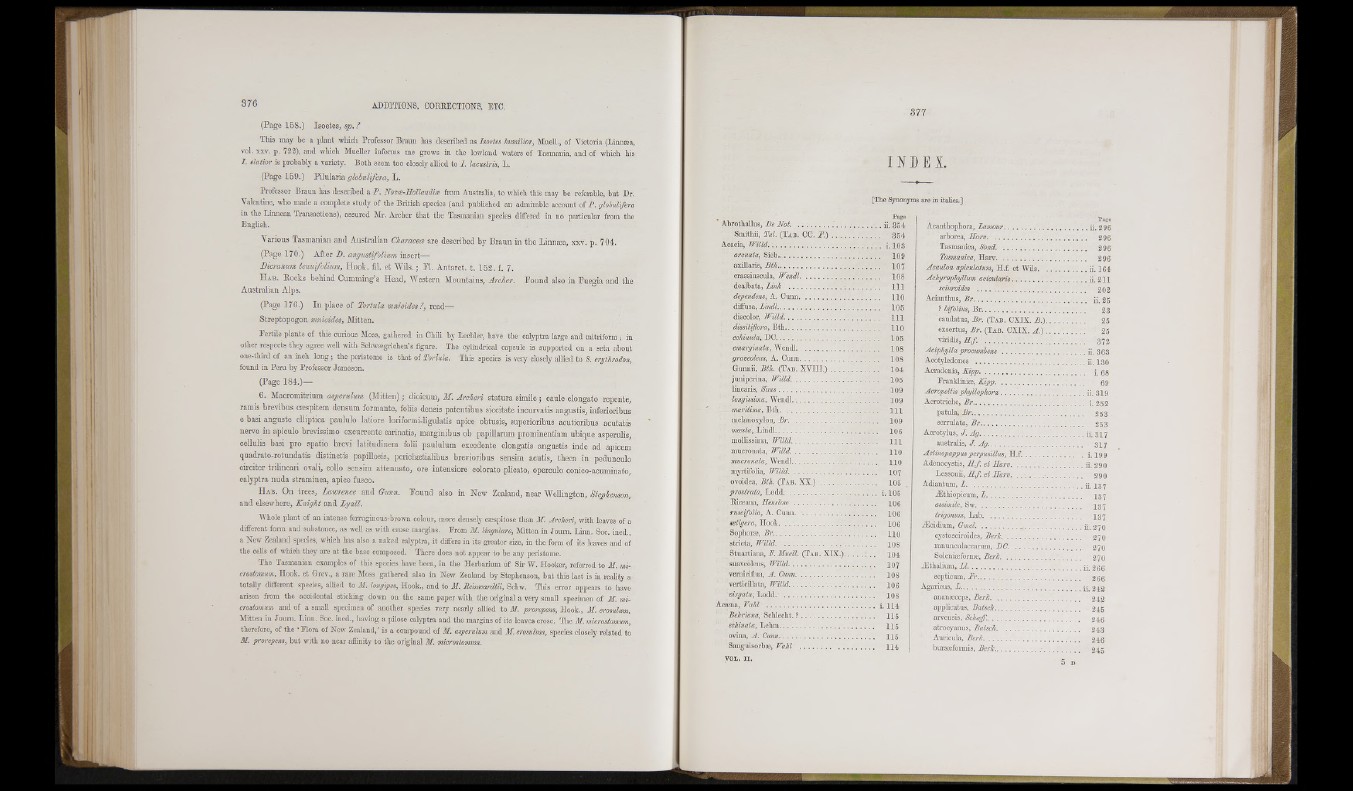
(Page 158.) Isoetes, sp. ?
Tliis may be a plant which Professor Braun has described as Isoetes kumilior, Muell,, of Victoria (Linnæa,
vol. XXV. p. 722), and which Mueller informs me gi'ows in the lowlaud watera of Tasmania, aud of which his
I. elatior is probably a variety. Both seem too closely allied to I. lacustris, L.
(Page 159.) Pilularia globulifera, L.
Professor Brauii has described a P. Novæ-Hollandiæ from Australia, to wbich this may be referable, but Dr.
Valentine, who made a complete study of the British species (and published au admirable account of P . globulifera
ill the Linneau Traiisactious), assured Mr. Archer that the Tasmaniau species differed in no particular from the
English.
Various Tasmanian and Australian Characece are described by Braun in the Linnæa, xxv. p. 704.
(Page 170.) After D. angustifolium insert—
Dicranum ienuifolium, Hook. fil. et Wils.; PI. Antarct. t. 152. f. 7.
Hab. Rocks behind Cuinming’s Head, Western Mountains, Archer. Pound also in Fuegia and the
Australian Alps.
(Page 176.) In place of Tortilla mnioides?, read—
Streptopogon mnioides, Mitten.
Fertile plants of tliis curious Moss, gathered in Chili by Lecbler, have the calyptra large and mitriforra ; in
other respects they agree well with Schwægrichen’s figime. The eylindrical capsule is supported on a seta about
one-third of an inch long ; the peristome is that of Toriula. This species is very closely allied to S. erythrodon,
fouud in Peru by Professor Jameson.
(Page 184.)—
6. Macromitrinm Ofyimi&m (Mitten); im om a , M. Ardoeri statum simile ; caule elongate repente,
ramis brevibus ciespitem densum formante, foliis densis patentibus siccitate incai-vatis angustis, inferioribus
e basi angoste elliptica paulnlo latiore loriformi-ligulatis apice obtnsis, superioribus acutioribus acntatis
nervo in apicnlo brevissimo excurrente carinatis, marginibus ob papiilarum prominentiam ubique asperulis,
cellulis basi pro spatio brevi latitudinem folii paululum excedente elongatis angustis inde ad apicem
quadrato-rotnndatis distinctis papillosis, perichætialibus brevioribns sensim acutis, theca in pedúnculo
circiter triliiieari ovali, collo sensim attenuato, ore intensiore colorato plicato, operculo conico-acuminato,
calyptra nuda straminea, apice fusco.
Hab. On trees, Lawrence and Gunn. Pound also in New Zealand, near Wellington, Stephenson,
and elsewhere, Knight and Lyall.
lYhole plant of an intense ferrnginous-brown colour, more densely cæspitose than M. Archeri, with leaves of a
different form and substance, as well as with erose margins. From M. lingulare. Mitten in Joum. Linn. Soc. ined.,
a New Zealand species, which has also a naked calyptra, it différa in its greater size, in the form of its leaves and of
the ceüs of which they are at the base composed. There does not appear to be any peristome.
The Tasmanian examples of this species have been, in the Herbarium of Sir W. Hooker, referred to M. microstomum,
Hook, et Grev., a rare Moss gathered also in New Zealand by Stephenson, but this last is in reaUty a
totally different species, allied to M. longipes. Hook., and to M., Reinwardtii, Schw. This error appears to have
arisen from the accidental sticking down on the same paper with the original a veiy small specimen of M. microstomum
and of a small specimen of another species veiy nearly allied to M. prorepens, Hook.. M. erosulum,
Mitten ill Joum. Linn. Soc. ined., having a pilose calyptra and the margins of its leaves erose. Tiic M. microstomum,
therefore, of the ‘ Flora of New Zealand,’ is a compound of M. asperulum and M. erosulum, species closely related to
M. prorepens, but with no near affinity to the original M. microstomum.
I NDE X .
[The Synonyms are in italics.]
Page
Abrothallus, Be Not...................... ii. 354
Smithii, Tul. (T a b . CC. / . ) ........................ 354
Acacia, Willd.........................................................i. 103
arcuata, Sieb....................................... 109
axillaris, Bth....................................... 107
crassiuscula, Wendl........................................ 108
. . . . I l l
. . . . 110
. . . . 105
. . . . I l l
. . . 110
. . . 105
. . . 108
ta, Link ..................................
dependens, A. Cunn.............................
diffusa, Lindl........................................
discolor, Willd...................................
dissitiflora, Bth...................................
echinula, DC........................................
emarginata, Wendl................................
graveolens, A. Cunn....................................... 108
Gunnii, Bth. (T a b . XVIII.)........................ 104
juniperina, Willd........................................... 105
linearis, Sims................................................. 109
longissima, Wend!.......................................... 109
maritima, Bth................................................. m
melauoxyloji, Br............................................ 109
meesta, Lindl.................................................. 106
mollissima, Willd........................................... m
muci-onata, Willd.......................................... n o
mucronata, Wendl.......................................... n o
myrtifolia, W illd .......................................... 107
ovoidea, Bth. (T a b . X X .)............................ 105
prostrata, i. 105
Kiceana, Henslow ......................................... lOC
ruscifoUa, A. Cunn. 106
■a. Hook................................................ 106
Sophoroe, Br................................................... n o
stricta, IVilld. ............................................. 108
Stuartiana, F. Muell. (T a b . X IX .) ............... 104
suaveolens, Willd.......................................... 107
vernicillua, A. Cunn............................ 108
verticillata, Willd......................................... 106
virgata-, Lodd................................................. 108
Acæiiü, Vahl j. 114
ReAmwa, Schlecht. ? .................................... I I 5
echinata, Lehm............................................... Hg
ovina, A. Cunn............................................... 115
Sangiiisorbæ, Fahl ..................................... 114
Acanthophora, Lamour..............................
arborea, Harv.......................................
Tasmanica, Sond. ..............................
Tasmanica, Harv..................................
Acaulon apiculatum, H.f. et Wils.............
Achyrophyllum acicularis...................................... ü.
sciuroides ...........................................
Acianthus, Br.............................................
? bifolius, Br.........................................
caudatus, Br. (Tab. CXIX. B.).........
exsertus, Br. (Tab. CXIX. A ) .........
vii-idis, H f. ......................................
Page
296
296
164
211
25
25
372
Acotyledones .............................................. ü. 130
Acrad en ia , Kipp...................................................... j. gg
F ra n ld in iæ , ATÿsj?....................................................... 69
.....................................................ii.3 1 9
...................................................... i .2 5 2
2 5 3
25 3
ü . 31 7
3 1 7
i. 199
ii. 2 90
Acrotriche, Br...........................
patula, B r . . . ......................
serrulata, Br.......................
Acrotylus, J. Ag.......................
austrahs, J. Ag..................
Actinopappus perpusillus, H.f. .
Adenocystis, H f. et Harv. .. .
Lessonii, H f. et Harv. .. .
Adiantum, L .............................
Æthiopicuiu, L...................
assimile, Sw..........................
trigonum, Lab.......................
Æcidium, Gmeî...........................
cystoseiroides. Berk.............
rauuiiculaceanun, BC. .. . .
Soleniæforme, Berk..............
Æthalium, Ll..............................
septicum, Fr.........................
Agaricus, L.................................
ananæceps, Berk...................
applicatus, Batsch................
arvensis, Sckæf....................
atrocyanus, Batsch...............
Auricula, Berk......................
buraæformis. Berk................
ü. 137
137
137
137
ii. 270
270
270
270
i. 266
266
i. 242
242
245
246
243
246
245